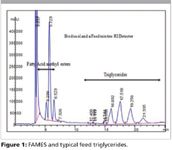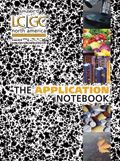A Novel, Simplified Methodology for the Analysis of Biodiesel by HPLC
Biodiesel is generally produced by the transesterification of vegetable oil or animal fat with methanol. The triglycerides present in the feed oil (vegetable oil or animal fat) are reacted with methanol in the presence of KOH as the catalyst.
Amrit Boparai, Asha A. Oroskar, and Anil R. Oroskar, Orochem Technologies, Inc.
Biodiesel is generally produced by the transesterification of vegetable oil or animal fat with methanol. The triglycerides present in the feed oil (vegetable oil or animal fat) are reacted with methanol in the presence of KOH as the catalyst. The reaction is carried out at approximately 60 °C for a few hours to form the fatty acid methyl esters (FAME). Other constituents formed during the reaction are the monoglycerides, diglycerides, and glycerol.
Since the feed oil generally consists of triglycerides of many fatty acids, normal phase and reverse phase HPLC chromatograms of the mixture of glycerol, mono-, di-, and triglycerides and the FAME are very complex with overlapping peaks of the constituents. This is further complicated when the feed oil may be a combination of vegetable and animal sources.
Orochem has developed a novel methodology for the analysis of Biodiesel components by utilizing HPLC. Sample preparation with a propritary Orpheus™ SPE sorbent enables a rapid separation of a biodiesel mixture into 2 fractions: the nonpolar fraction A contains the triglycerides and the fatty acid methyl esters or FAMEs; and the polar fraction B contains glycerol, mono-, and diglycerides. Both the fractions A and B, separated through Orochem's Orpheus™ SPE protocols are then analyzed separately on an HPLC using an Orochem Reliasil-BD C-18 analytical HPLC column optimized for Biodiesel separation.
Procedure
A 0.5 mL aliquot of a methylene chloride solution of the biodiesel sample to be analyzed is applied to a 6-mL Orpheus™ Biodiesel cartridge. The mixture is separated into a nonpolar fraction A (esters and triglycerides) and a polar fraction B (mono- and diglycerides and glycerol) using methanol/methylene chloride as the eluant. Fractions A and B are then analyzed by HPLC.
The figure shows separation of biodiesel and the feed triglycerides on an Orochem proprietary 250 × 4.6 mm C-18 Reliasil-BD HPLC column optimized for the analysis of biodiesel components. Using optimized methylene chloride in methanol as the mobile phase and a refractive index detector, esters and triglycerides are eluted within 25 min.

Figure 1

Orochem Technologies, Inc.
331 Eisenhower Ln South, Lombard, IL 60148
tel. (630)916-0225
Website: www.orochem.com

SEC-MALS of Antibody Therapeutics—A Robust Method for In-Depth Sample Characterization
June 1st 2022Monoclonal antibodies (mAbs) are effective therapeutics for cancers, auto-immune diseases, viral infections, and other diseases. Recent developments in antibody therapeutics aim to add more specific binding regions (bi- and multi-specificity) to increase their effectiveness and/or to downsize the molecule to the specific binding regions (for example, scFv or Fab fragment) to achieve better penetration of the tissue. As the molecule gets more complex, the possible high and low molecular weight (H/LMW) impurities become more complex, too. In order to accurately analyze the various species, more advanced detection than ultraviolet (UV) is required to characterize a mAb sample.

.png&w=3840&q=75)

.png&w=3840&q=75)



.png&w=3840&q=75)



.png&w=3840&q=75)













